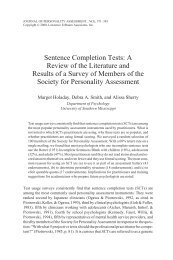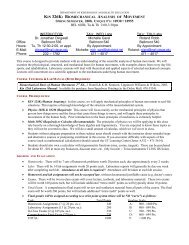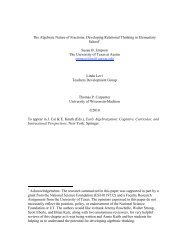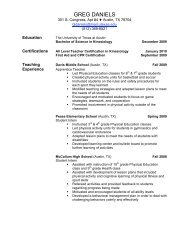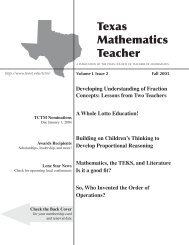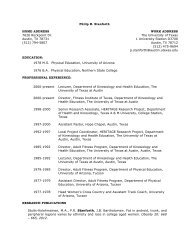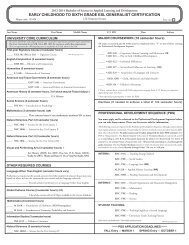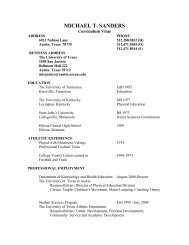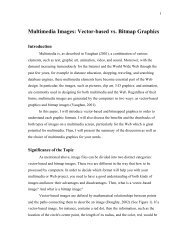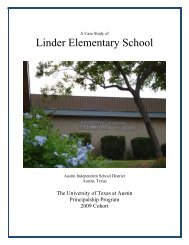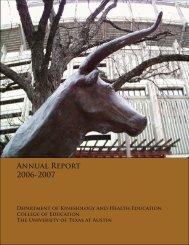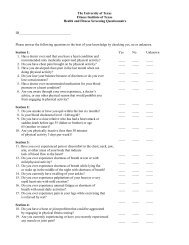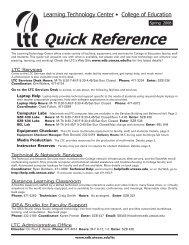High Schools: Size Does Matter - The College of Education - The ...
High Schools: Size Does Matter - The College of Education - The ...
High Schools: Size Does Matter - The College of Education - The ...
You also want an ePaper? Increase the reach of your titles
YUMPU automatically turns print PDFs into web optimized ePapers that Google loves.
Small <strong>Schools</strong> Page 6 <strong>of</strong> 7<br />
Issue Brief Vol. 1, Issue 1<br />
<strong>The</strong> work reported here<br />
is an outgrowth <strong>of</strong> the<br />
larger Houston A+<br />
Challenge initiative.<br />
Conclusion<br />
Within the last several years, the renewed<br />
small schools movement has been heading<br />
towards breaking up large comprehensive<br />
high schools into schools-within-schools<br />
serving between 200 and 500 students<br />
(Gregory, 2001). Dewees (1999) wrote,<br />
“While considerable data exists on<br />
outcomes associated with small schools,<br />
there is much less evidence about<br />
outcomes associated with school-within-aschool<br />
programs (Cotton, 1996b)” (p. 1).<br />
However, this model <strong>of</strong> small schools is<br />
believed to be a cost-effective approach to<br />
school reform in terms <strong>of</strong> start-up costs<br />
and, in some cases, maintenance.<br />
Additionally, Dewees cited evidence that<br />
References<br />
Ancess, J., & Ort, S. W. (1999). How the coalition<br />
campus schools have re-imagined high school:<br />
Seven years later. New York: National Center for<br />
Restructuring <strong>Education</strong>, <strong>Schools</strong>, and Teaching.<br />
Ayers, W. (2000). Simple justice: Thinking about<br />
teaching and learning, equity, and the fight for<br />
small schools. In W. Ayers, M. Klonsky, & G.<br />
Lyon (Eds.), A simple justice: <strong>The</strong> challenge <strong>of</strong><br />
small schools. New York: Teachers <strong>College</strong> Press.<br />
Cotton, K. (2001). New small learning communities:<br />
Findings from recent literature. Portland, OR:<br />
Northwest Regional <strong>Education</strong>al Laboratory.<br />
Darling-Hammond, L. (1997). <strong>The</strong> right to learn: A<br />
blueprint for creating schools that work. San<br />
Francisco: Jossey-Bass.<br />
Dewees, S. (1999). <strong>The</strong> school-within-a-school<br />
model (ERIC Digest). Charleston, WV: ERIC<br />
Clearinghouse on Rural <strong>Education</strong> and Small<br />
<strong>Schools</strong>.<br />
Fowler, W., & Walberg, H. J. (1991). School size,<br />
characteristics, and outcomes. <strong>Education</strong>al<br />
Evaluation and Policy Analysis, 13(2), 189-202.<br />
Gregory, T. (2001). Breaking up large high schools:<br />
Five common (and understandable) errors <strong>of</strong><br />
execution. Charleston, WV: ERIC Clearinghouse<br />
on Rural <strong>Education</strong> and Small <strong>Schools</strong>.<br />
Haller, E. J., Monk, D. H., Spotted Bear, A., Griffith,<br />
J., & Moss, P. (1990). School size and program<br />
comprehensiveness: Evidence from <strong>High</strong> School<br />
downsized school models can have a<br />
positive social impact on students.<br />
Some <strong>of</strong> the critiques <strong>of</strong> the school-withina-school<br />
model, as cited in Dewees (1999),<br />
include the creation <strong>of</strong> divisiveness in<br />
schools due to organizational realignment;<br />
conflicts concerning allegiances to the<br />
larger school versus the smaller school<br />
unit, thus creating rivalries (Muncey &<br />
McQuillan, 1991; Raywid, 1996b, both as<br />
cited in Dewees); inequitable tracking if<br />
only one population is targeted for a<br />
subschool (McMullan, Sipe, & Wolfe, 1994;<br />
Raywid, 1996a, both as cited in Dewees);<br />
and the model may negatively affect school<br />
coherence and the role <strong>of</strong> the principal.<br />
and Beyond. <strong>Education</strong>al Evaluation and Policy<br />
Analysis, 12(2), 109-120.<br />
Howley, C., Strange, M., & Bickel, R. (2000).<br />
Research about school size and school<br />
performance in impoverished communities.<br />
Charleston, WV: ERIC Clearinghouse on Rural<br />
<strong>Education</strong> and Small <strong>Schools</strong>.<br />
Klonsky, M. (2000). Remembering Port Huron. In<br />
W. Ayers, M. Klonsky, & G. Lyon (Eds.), A simple<br />
justice: <strong>The</strong> challenge <strong>of</strong> small schools. New<br />
York: Teachers <strong>College</strong> Press.<br />
Lawrence, B. K., Bingler, S., Diamond, B. M., Hill,<br />
B., H<strong>of</strong>fman, J. L., Howley, C. B., Mitchell, S.,<br />
Rudolph, D., & Washor, E. (2002). Dollars and<br />
sense: <strong>The</strong> cost effectiveness <strong>of</strong> small schools.<br />
Cincinnati, OH: Knowledge Works Foundation.<br />
Lee, V. E., & Smith, J. B. (1995). Effects <strong>of</strong> high<br />
school restructuring and size on early gains in<br />
achievement and engagement. Sociology <strong>of</strong><br />
<strong>Education</strong>, 68, 241-270.<br />
Lee, V. E., & Smith, J. B. (1997). <strong>High</strong> school size:<br />
Which works best and for whom? <strong>Education</strong>al<br />
Evaluation and Policy Analysis, 19(3), 205-227.<br />
Pittman, R. B., & Haughwout, P. (1987). Influence<br />
<strong>of</strong> high school size on dropout rate. <strong>Education</strong>al<br />
Evaluation and Policy Analysis, 9(4), 337-343.<br />
Raywid, M. (1998). Current literature on small<br />
schools. Charleston, WV: ERIC Clearinghouse<br />
on Rural <strong>Education</strong> and Small <strong>Schools</strong>.



